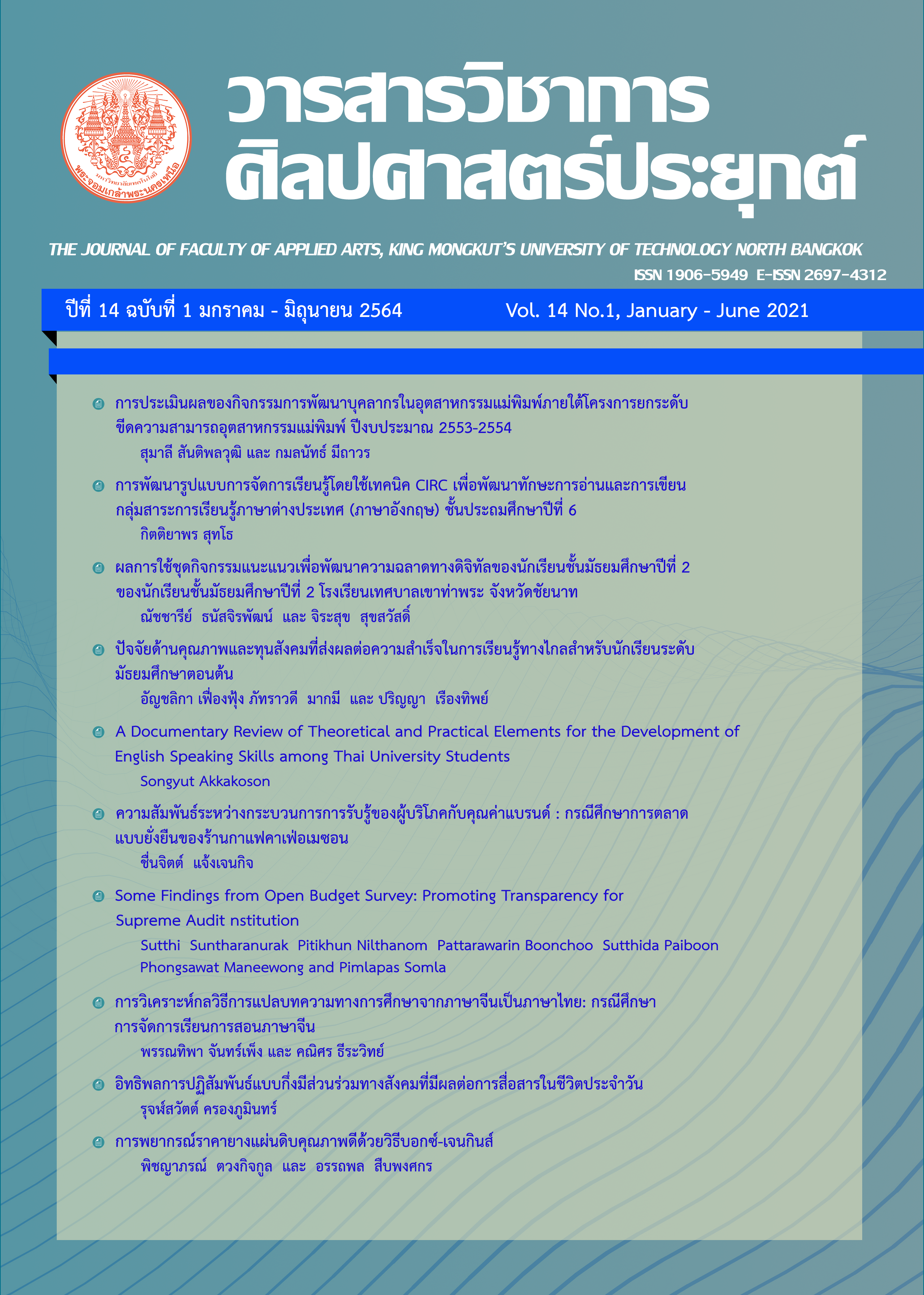อิทธิพลการปฏิสัมพันธ์แบบกึ่งมีส่วนร่วมทางสังคม ที่มีผลต่อการสื่อสารในชีวิตประจำวัน
Main Article Content
บทคัดย่อ
บทความนี้มุ่งศึกษาอิทธิพลการสื่อสาร การมีปฏิสัมพันธ์แบบกึ่งมีส่วนร่วมทางสังคม ซึ่งเป็นปรากฏการณ์ที่แสดงถึงความสัมพันธ์ระหว่างผู้รับสารในฐานะผู้ชมกับบุคคลที่มีชื่อเสียงทางสังคม โดยมีลักษณะการจินตนาการ และมีความรู้สึกร่วมว่า มีความใกล้ชิด สนิทสนมกันเหมือนเป็นเพื่อนในโลกความเป็นจริง การสื่อสารรูปแบบนี้กำลังเกิดขึ้นอย่างกว้างขวางในโลกการสื่อสารยุคโลกาภิวัตน์ปัจจุบัน ส่งผลต่อทัศนคติ ความคิด การรับรู้ การเลือกใช้เลือกปฏิบัติ รวมไปถึงภาวะทางอารมณ์ของผู้รับสาร ที่นำไปสู่การมีอิทธิพลต่อการสื่อสารในชีวิตประจำวันในด้านต่างๆ ไม่ว่าจะเป็น อิทธิพลด้านการสื่อสารสุขภาพ อิทธิพลด้านการสื่อสารการเมือง และอิทธิพลด้านการสื่อสารกับการตัดสินใจซื้อของผู้บริโภค อิทธิพลของการสื่อสารกันในรูปแบบการมีปฏิสัมพันธ์แบบกึ่งมีส่วนร่วมทางสังคม ที่มีผลต่อการสื่อสารในชีวิตประจำวันในด้านต่างๆ นั้น ได้ทำให้เกิดการสร้างบุคคลในสื่อเสมือนเป็น ตัวแม่แบบ ที่สมควรค่าโดยสนิทใจในการลอกเลียนพฤติกรรมนั้นอย่างไม่ลังเลใจ อันจะนำมาซึ่งการเปลี่ยนแปลงพฤติกรรมของผู้รับสาร ความตระหนักรู้ หรือเพื่อขับเคลื่อนในประเด็นต่างๆ ที่มีความสำคัญในโลกแห่งความเป็นจริงให้เกิดผลสัมฤทธิ์เป็นรูปธรรมต่อไป
Article Details

อนุญาตภายใต้เงื่อนไข Creative Commons Attribution-NonCommercial-NoDerivatives 4.0 International License.
1.บทความที่ตีพิมพ์เป็นลิขสิทธิ์ของวารสารวิชาการศิลปศาสตร์ประยุกต์ การนำเนื้อหา ข้อความหรือข้อคิดเห็น รูปภาพ ตาราง ของบทความไปจัดพิมพ์เผยแพร่ในรูปแบบ ต่าง ๆ เพื่อใช้ประโยชน์ในเชิงพาณิชย์ ต้องได้รับอนุญาตจากกองบรรณาธิการวารสารอย่างเป็นลายลักษณ์อักษร
2.ข้อความที่ปรากฏในบทความแต่ละเรื่อง เป็นความคิดเห็นส่วนตัวของผู้เขียนแต่ละท่านไม่เกี่ยวข้องกับวารสารวิชาการศิลปศาสตร์ประยุกต์ และบุคลากร คณาจารย์ท่านอื่น ๆ ในวารสารฯ แต่อย่างใด ความรับผิดชอบองค์ประกอบทั้งหมดของบทความแต่ละเรื่องเป็นของผู้เขียนแต่ละท่าน หากมีความผิดพลาดใด ๆ ผู้เขียนแต่ละท่านจะรับผิดชอบบทความของตนเองแต่ผู้เดียว
เอกสารอ้างอิง
กาญจนา แก้วเทพ. (2552). สื่อสารมวลชน ทฤษฎีและแนวทางการศึกษา. กรุงเทพมหานคร: ห้างหุ้นส่วนจำกัดภาพพิมพ์.
โคทม อารียา. (2552). แนวคิดการสื่อสารสุขภาพ. นนทบุรี: แผนงานวิจัยและพัฒนาระบบสื่อสาร สุขภาพสู่ประชาชน.
ปาจรีย์ ธนะสมบูรณ์กิจ. (2551). สื่อสารด้วยได้สุขภาพดี. นนทบุรี: แผนงานวิจัยและพัฒนาระบบสื่อสารสุขภาพสู่ประชาชน.
Altheide, D. L. (2008). Media Logic and Political Communication in Political communication. London: Sage Publications
Bandura, A. (1977). Social Learning Theory. New York: General Learning Press.
Becker, L. (1975). The Development of Political Cognition, In Political Communications: Issues and Strategies for Research. Beverly Hills: Sage.
Brown, W. J. & Basil, M. D. (1995). Media Celebrities and Public Health: Responses to Magic Johnson's HIV Disclosure and Its Impact on AIDS Risk and High risk Behaviors. Health Communication Journal, 7(4), 345-370.
Lim, C. M. & Kim, Y. (2011). Older Consumers’TV Home Shopping:Loneliness, Parasocial Interaction, and Perceived Convenience. Psychology & Marketing, 28(8), 763–78.
Lee E. J. & Youn Oh S., (2012). To Personalize or Depersonalize When and How Politicians Personalized Tweets Affect the Public’s Reactions. Journal of Communication, 62, 932-949.
Horton, D. & Wohl R.R, (1956). Mass communication and parasocial interaction : Observation on intimacy at a distance. Psychiatry, 19(3), 215-229.
Koenig F. & Lessan G, (1985). Viewers Relationship to Television Personalities. Psychological Reports, 57, 263-266.
Kotler, P. (2003). Marketing Management. Upper sanddle river, New Jersey: Prentice Hall.
Labrecque L. I. (2014). Fostering consumer brand relationships in social media environments: the role of
parasocial interaction. Journal of Interactive Marketing, 28(2), 134–148.
Levy, M. R. (1979). Watching TV news as parasocial interaction. Journal of Broadcasting, 23(1), 177-187.
McQuail, D. (2000). McQuail's mass communication theory (4th ed.). Thousand Oaks, CA: Sage.
Paravati, E., Naidu, E., Gabriel, S. & Wiedemann, C. (2019). More Than Just a Tweet: The Unconscious Impact of Forming Parasocial Relationships Through Social Media. Psychology of Consciousness: Theory. Research, and Practice, 1-16. doi: 10.1037/cns0000214
Rasmussen, L. (2018). Parasocial Interaction in the Digital Age: An Examination of Relationship Building and the Effectiveness of YouTube Celebrities. The Journal of Social Media in Society, 7(1), 280-294.
Rubin A.M. & Perse E.M, (1987). Audience activity and soap opera involvement: A uses and effects investigation. Human Communication Research, 14, 246–68.
Singhal, A. & Rogers, E. M. (2002). A theoretical agenda for Entertainment education. Communication theory, 12(2), 117-135.


